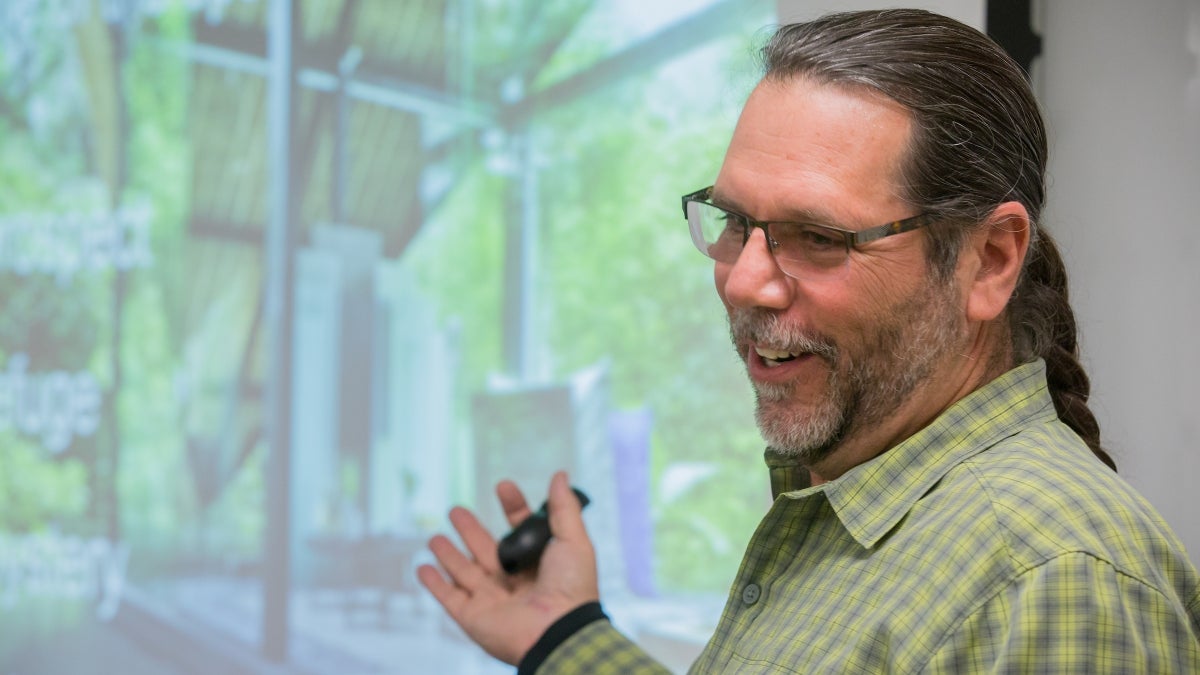When Joe Zazzera first walked onto floor of a telecommunications plant, he had one thought: “I can’t do this.”
In the windowless room, surrounded by barrels of chemicals and buzzing machinery, Zazzera was completely cut off from the natural world he loves.
Now, as a practitioner of biophilicLove of natural life. design, he works to bring nature inside, enhancing productivity, reducing stress and improving well-being.
Zazzera, founder of Plant Solutions, and Sonja Bochart, an interior designer who integrates principles of biophilia into her work, lectured on the topic yesterday at Arizona State University. Zazzera and Bochart are also adjunct faculty at ASU.
“Nature brings great value to our lives,” Bochart said. “Connection to the land is biophilia. … There’s a wild quality in nature we’re drawn to.”
The idea is simple. When you’re hiking or watching a nature video, you feel better. Blood pressure drops and parasympathetic healing activates. Sterile modern buildings such as office towers cut us off from that. And we spend, according to Bochart, 90 percent of our time indoors.
“You bring in light and life, and it fills us,” she said.
Adjunct faculty member Sonja Bochart talks with a couple of people following a lunchtime lecture on biophilia and biomimicry on Thursday, Feb. 2. The topics relate to the integration of nature into home, school and business environments. She is an interior designer who integrates principles of biophilia into her work. Photo by Charlie Leight/ASU Now
Biophilic design elements include environmental features like natural materials, water, and “living walls” planted with moss or hanging plants; natural shapes and forms; natural patterns and processes, including changing copper patinas. A place-based relationship is also important. A building in Phoenix should not be interchangeable with one in Seattle or Chicago.
Bochart called biophilia a balance between art and science, and it’s something science has plenty of evidence to support.
Views of nature reduce post-operative hospital stays by 8.5 percent, and lower blood pressure and heart rate. Morning sun reduces hospital stays of bipolar patients 26 to 30 percent. Natural ventilation reduces sick time 57 percent and hospital stays almost 35 percent.
In learning, natural daylight raises test scores and heightens learning rates. The presence of water improves concentration and memory restoration. A visual connection to nature improved mental engagement and attentiveness.
Retailers, pay attention. Day lighting increased sales per square foot and increased average sales 6 percent. The presence of trees increased willingness to pay 15 to 25 percent more for the same items.
In offices, indoor plants reduce sick building syndromes 21 percent. A view of nature can result in 6 to 7 percent faster call handling time at call centers. And natural ventilation can cut sick leave more than 57 percent and doctor visits almost 17 percent.
Biophilic design is “not just bringing plants indoors,” Zazzera said. As the founder of Plant Solutions Inc., he designs living walls, indoor atriums, living plant scapes and moss wall art.
Biophilic design increases the overlap between the human and natural worlds.
“Hopefully, in the future there won’t be a difference,” Zazzera said. “Corporations are waking up to this.”
The lecture was sponsored by the Julie Ann Wrigley Global Institute of Sustainability as part of their Sustainability Series, where speakers discuss a range of environmental, social, and economic topics. The series is free and open to the public.
Top photo: Adjunct faculty member Joe Zazzera talks with around 50 people at a lunchtime lecture on biophilia and biomimicry on Feb. 2. Photo by Charlie Leight/ASU Now
More Environment and sustainability

The future is green: Job demand translates to high employability for ASU sustainability grads
A 2023 report by Forbes on the state of green jobs confirmed what Arizona State University has been trumpeting for years: Sustainability will play a large part in the new economy.The report suggests…

Researcher works on changing people's mindsets to fight climate change
Meaningful action to heal the climate requires a complete shift in the way people think and perceive each other, according to an expert on social transformation who spoke at Arizona State University…

NOAA, ASU offer workshop to bridge ocean exploration, education
Oceans are vital to sustaining life on Earth, as they produce over half of the oxygen we breathe and play a crucial role in regulating the planet's climate. They also support a diverse array of…

